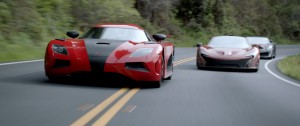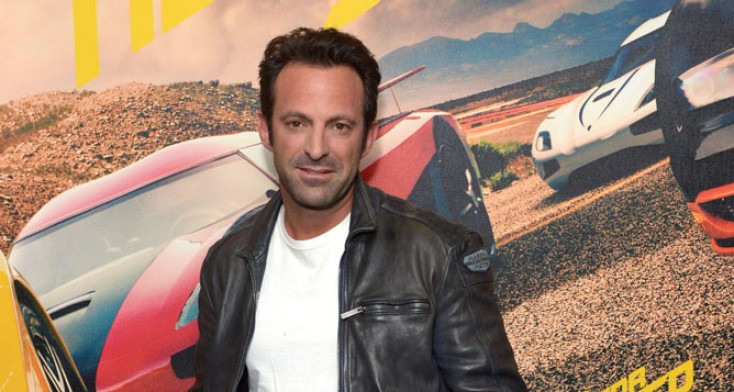
Scott Waugh’s NEED FOR SPEED chronicles a near-impossible cross-country race against time — one that begins as a mission for revenge, but proves to be one of redemption. ©DreamWorks II Distribution Co., LLC. All Rights Reserved.
By ANGELA DAWSON
Front Row Features
HOLLYWOOD—Filmmaker Scott Waugh, whose action-packed street-racing thriller “Need for Speed” opens Friday, knows a little something about action movies. A second generation stunt man—his father, Fred Waugh was the man behind the mask on “The Amazing Spider-Man” TV series that ran in the late 1970s—Waugh wanted to pay homage to his late father by having practical stunts in his new movie rather than relying on special effects.
Though he is now the man behind the camera rather than performing stunts on camera—he retired from stunt work in 2005 to start his own production company, making videos with immersive audio-visual content—Waugh has begun what promises to be an exciting second career as a feature film director. His feature debut was 2012’s “Act of Valor,” which opened at No. 1 in the U.S., and grossed more than $80 million worldwide.
Waugh, who also executive produced and edited “Need for Speed,” based on the popular video game, believes incorporating real stunts into his films make it more exciting for moviegoers. He worked closely with his stunt coordinator Lance Gilbert, whose father, Mickey, also was a stunt man, to conceive some real nail-biting stunts, including an old gem their dads once did, which they refer to as “the grasshopper.”
Waugh recently spoke about making “Need for Speed,” which stars “Breaking Bad’s” Aaron Paul as the owner of a high-performance garage who is set up to take the fall for the death of a fellow illegal street racer. After two years in prison, Paul’s Tobey Marshall is out hell-bent on exacting revenge against the man who put him there. What better way to do it than to beat his foe in a secretly organized illegal street race halfway across the country?
Q: How did you cast Aaron Paul?
Waugh: Casting is really important to me and I spent a long time on it, because I wanted to find the next young Steve McQueen because Steve harnessed three things that are really important: danger, charisma and likability. Those are really three attributes that are hard to get all three of. Aaron’s name came up for the bad guy. I saw the tape on him and I was like, “Oh my God! That’s the obvious choice, but the more interesting choice is the lead.” That defines the movie we’re making. He’s a unique, interesting person. They said the studio would never go for that. That’s too edgy, and I was like that’s the movie we should be making.
Q: What made you decide that you wanted to make this movie without CGI?
Waugh: I almost never use CGI. I think they knew that when they hired me. They knew (practical stunts) was what they were going to get. I’m not a fan of CGI. I feel like it’s the easy way out, unless you’re doing like a futuristic movie that’s in a completely other world, like “Avatar.” In a car movie, it should be practical. It should be real. We hired (stunt coordinator) Lance Gilbert to come up with stuff that’s real; that we can do practically. When we conceived this film, I really wanted to do a throwback to the movies that Lance and I grew up on that were the ones we still quote today as the greatest car movies of all time, which are “Bullitt,” “Vanishing Point, “Smokey and the Bandit” and “The French Connection.” You look at these films, and you try to figure out why are they still the best. It’s because the (action sequences are) real. In the ‘60s and the ‘70s, they didn’t do CGI. There’s no big music montage. It’s just motor noise. It’s something we really focused on throughout the whole film.
Q: Does shooting practical limit your editing options, because you’re confined to what you shot? There’s not as much opportunity to manipulate the footage.
Waugh: No. I mean not if you think it properly through. I’ve edited everything I’ve ever done. I’ve been an editor for 10 years and I look at it from that viewpoint when I film. I don’t just go spray footage, because I think I’m going to cover it from every angle. I want to cover it from the right angles to get the footage I need for the edit bay. I don’t find it limiting at all. First of all, I shoot with 27 cameras (rolling), so if I miss the shot I want, then I’m an idiot. (He laughs.)
Q: How did you go about determining what type of action sequence would be like doing the grasshopper? How is that plotted out?
Waugh: Lance’s dad and my dad did this jump together in a car (in 1978) for “Our Winning Season.” They jumped the car through a drive-in movie theater screen and it was huge. But they did it for real and it was practical and I was like, “We need to do that in this movie out of respect for our fathers.” My dad passed away when we were in pre-production for this movie and I really wanted to dedicate this movie to all the things that he was able to accomplish in his career, so that was one of the reasons we wanted to do the grasshopper. I needed it to be practical. It’s got to be real and we’re going to really jump it and he needs to drive away. He can’t like land and grenade the car. It’s in the middle of the movie. He’s got to land and drive away.
Q: How crucial was to convince the European car manufacturers to release the proprietary specs so that the cars could be customized for the film?
Waugh: It was huge. With the video game, which was wonderful, they have such a great relationship with all of the supercar manufacturers, because the game wants to get it authentic and right and so do the manufacturers. They want to make sure that their cars in the game look exactly the way they do in real life, so with that came a great relationship. When we had to go to these manufacturers and say we need your CAD files, which are like the Holy Grail for each car, because it’s exactly how they build these cars. You just don’t hand it over to anybody, but because they knew it was for the game and in one respect for a movie for the game, they knew that we wanted to do it accurately. There were a lot of (non-disclosure agreements) that had to be signed and everything. We worked with a great company that was able to build the supercars that we wanted to wreck, because the supercars that we had, I didn’t want to wreck. It was one of three Lamborghini Elementos in the world. What was I going to do? Bring it down to two? That would have been… disrespectful. They’re art pieces. Those cars are not designed to flip and wreck; they’re designed to go fast and stay upright and we want to make sure that they’re extremely safe for our stuntmen that were going to wreck them, So we needed those CAD files to build a race car that had a proper roll cage and a flipping devices so we could get these cars to flip the way we needed and that Lance could make sure that the guys doing it were going to be safe. We did that with all the supercars, because why wreck a $2.5 million Bugatti when you could build something a lot cheaper that looks just like it, because it’s only purpose is to go get wrecked.
Q: Has coming up with new stunts changed from when you started out as a stunt man?
Waugh: I retired in 2005, so it’s been almost 10 years. When I watch what Lance and the guys have with new technology, I see that it has allowed us to push the envelope with stunts farther. But what I find back in the older days is they were the real cowboys. They were like hardcore stuntmen. My father and Lance’s father were the real deal. They really got wrecked and hurt, and doing things that were really pushing the envelope. I find that with today’s technology, we can just make it a little bit safer, because we have better airbags, we have better devices to launch people, better roll cages, so you know that the car is not going to get crushed.
Q: Capturing those high speed races must have been tricky to film.
Waugh: Yeah. We needed to build a faster camera car, because most camera cars top out at about 110-120 mph. So we were going to travel way faster than that and we looked at a lot of platforms and ended up building a supercharged Mustang that was a car that we could keep up with the supercars and we built these crazy rail systems on the front and rear that would give us mobility with the camera instead of just – normally, we’d hard-mount the camera to the front, but we wanted to have a head that you can put out there, so I can pan back and forth and slide the camera back and forth between cars and our high-speed Mustang was kind of our little assault weapon that we would bring out with the supercar races. We brought out Steve Holladay, one of the famous race car driver stuntmen, to drive for us, because you start pushing the envelope of those speeds, you want the best of the best and people who have driven those speeds a lot. That was the secret toy that really showed us how fast we’re really going.
Q: Was the disclaimer warning audiences not to try these high-speed stunts always in the credits, or was that put in after the death of (“Fast and Furious” actor) Paul Walker?
Waugh: The disclaimer has been on all “Fast and Furious” movies. It kind of goes on all car movies. It’s just us saying, “Hey movies are movies. They’re there to entertain you.” You don’t watch “Oceans Eleven” and go to Vegas and rob a casino.





